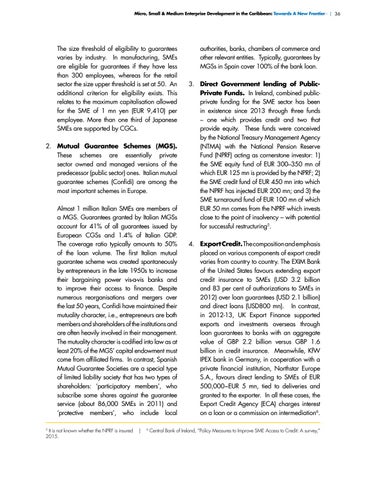Micro, Small & Medium Enterprise Development in the Caribbean: Towards A New Frontier - | 36
The size threshold of eligibility to guarantees varies by industry. In manufacturing, SMEs are eligible for guarantees if they have less than 300 employees, whereas for the retail sector the size upper threshold is set at 50. An additional criterion for eligibility exists. This relates to the maximum capitalisation allowed for the SME of 1 mn yen (EUR 9,410) per employee. More than one third of Japanese SMEs are supported by CGCs.
2. Mutual Guarantee Schemes (MGS). These schemes are essentially private sector owned and managed versions of the predecessor (public sector) ones. Italian mutual guarantee schemes (Confidi) are among the most important schemes in Europe.
Almost 1 million Italian SMEs are members of a MGS. Guarantees granted by Italian MGSs account for 41% of all guarantees issued by European CGSs and 1.4% of Italian GDP. The coverage ratio typically amounts to 50% of the loan volume. The first Italian mutual guarantee scheme was created spontaneously by entrepreneurs in the late 1950s to increase their bargaining power vis-a-vis banks and to improve their access to finance. Despite numerous reorganisations and mergers over the last 50 years, Confidi have maintained their mutuality character, i.e., entrepreneurs are both members and shareholders of the institutions and are often heavily involved in their management. The mutuality character is codified into law as at least 20% of the MGS’ capital endowment must come from affiliated firms. In contrast, Spanish Mutual Guarantee Societies are a special type of limited liability society that has two types of shareholders: ‘participatory members’, who subscribe some shares against the guarantee service (about 86,000 SMEs in 2011) and ‘protective members’, who include local
5 It is not known whether the NPRF is insured 2015.
|
6
authorities, banks, chambers of commerce and other relevant entities. Typically, guarantees by MGSs in Spain cover 100% of the bank loan. 3. Direct Government lending of PublicPrivate Funds. In Ireland, combined publicprivate funding for the SME sector has been in existence since 2013 through three funds – one which provides credit and two that provide equity. These funds were conceived by the National Treasury Management Agency (NTMA) with the National Pension Reserve Fund (NPRF) acting as cornerstone investor: 1) the SME equity fund of EUR 300–350 mn of which EUR 125 mn is provided by the NPRF; 2) the SME credit fund of EUR 450 mn into which the NPRF has injected EUR 200 mn; and 3) the SME turnaround fund of EUR 100 mn of which EUR 50 mn comes from the NPRF which invests close to the point of insolvency – with potential for successful restructuring5. 4. Export Credit. The composition and emphasis placed on various components of export credit varies from country to country. The EXIM Bank of the United States favours extending export credit insurance to SMEs (USD 3.2 billion and 83 per cent of authorizations to SMEs in 2012) over loan guarantees (USD 2.1 billion) and direct loans (USD800 mn). In contrast, in 2012-13, UK Export Finance supported exports and investments overseas through loan guarantees to banks with an aggregate value of GBP 2.2 billion versus GBP 1.6 billion in credit insurance. Meanwhile, KfW IPEX bank in Germany, in cooperation with a private financial institution, Northstar Europe S.A., favours direct lending to SMEs of EUR 500,000−EUR 5 mn, tied to deliveries and granted to the exporter. In all these cases, the Export Credit Agency (ECA) charges interest on a loan or a commission on intermediation6.
Central Bank of Ireland, “Policy Measures to Improve SME Access to Credit: A survey,”
